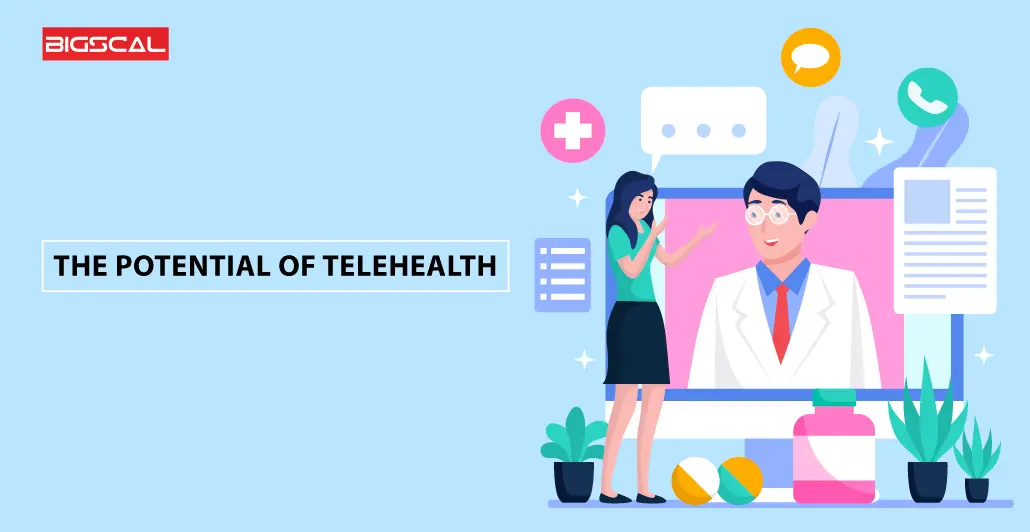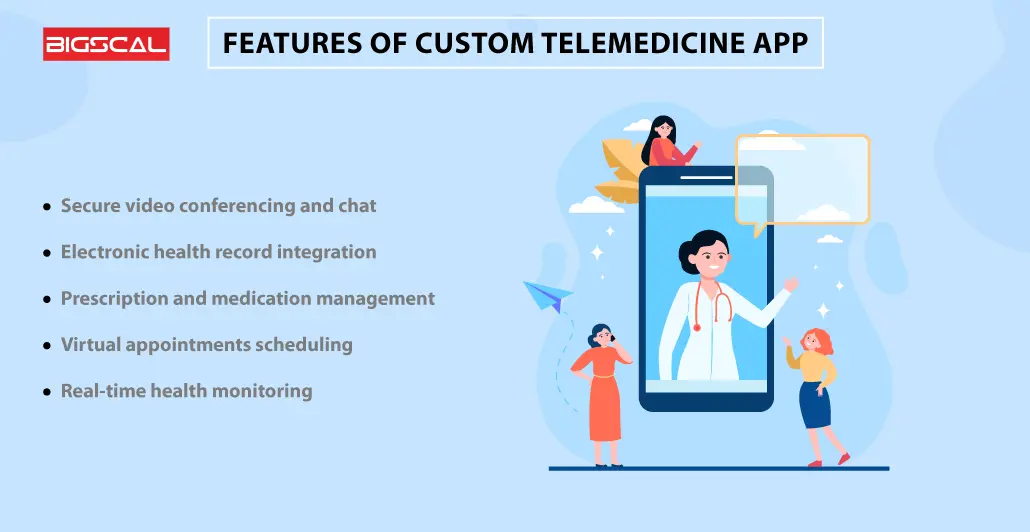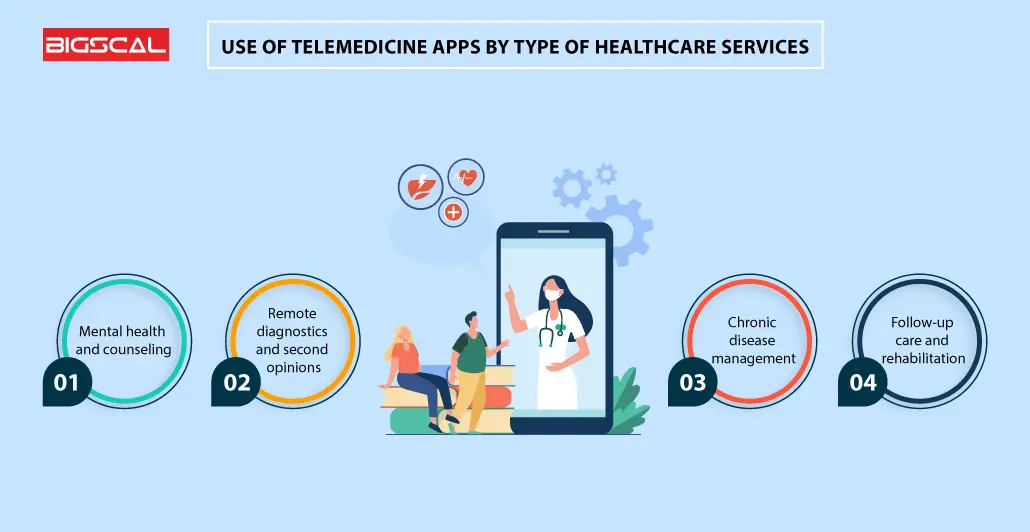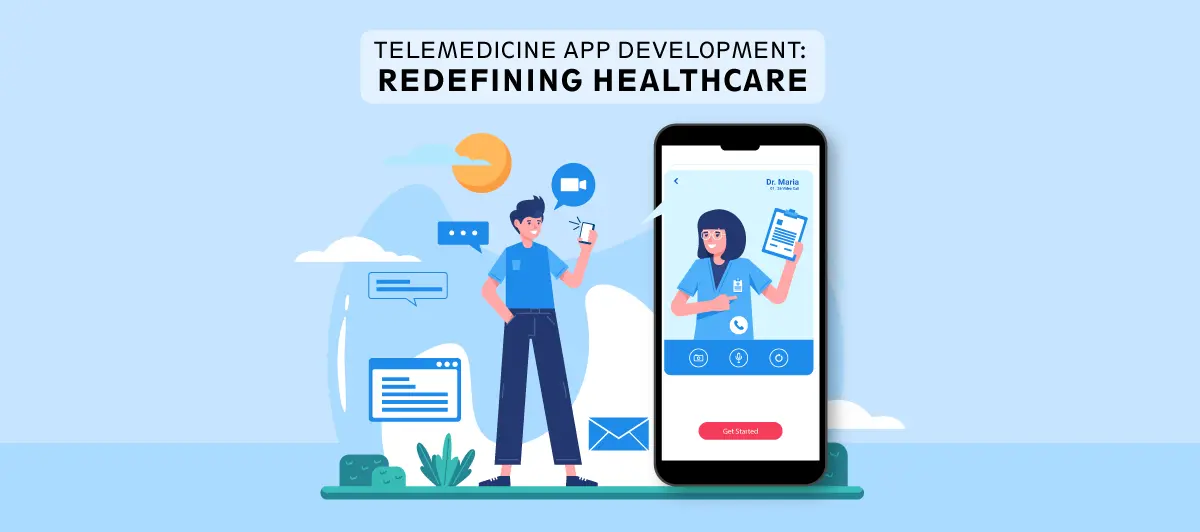Exploring the Versatile Uses of Telemedicine App Development
Quick Summary: Exploring the uses of telemedicine app development reveals its diverse applications, from remote consultations to diagnostics. These apps enhance healthcare accessibility, facilitate collaboration, and revolutionize medical services while facing data security and equitable access challenges.
Introduction of Uses of Telemedicine
Uses of Telemedicine app development is the most transformative trend that has taken over the entire healthcare industry. It is bringing about change in both how patients access healthcare services and how physicians deliver them. Hence this innovative technology lets patients and health care providers connect remotely without geographical restrictions. It can eventually result in a better healthcare experience.
The various uses of telemedicine platforms extend beyond routine, medical education and consultations. Integrating advanced features like video chat, electronic health records, secure messaging, and real-time data sharing can make treatment plans easier. It opens the door to providing exceptional care and remote medical supervision without in person visit. Hence the impact of telemedicine company in healthcare for people living in remote areas is major.
Moreover, telehealth services contribute to optimizing healthcare resources by solving the problem of hospital overcrowding. This text will shed light on the potential use of telemedicine and app development for accessibility, convenience, and quality healthcare services.
What is a telemedicine app?
A Telemedicine app is a way that helps get access to healthcare appointments with doctors, medical specialists and, or a nurse practitioner over the Internet. All of these can be done only using mobile devices or computers. Hence you can fix your appointments and conduct them through video calls. The list of services available in a telemedicine app is as follows;
- online chat messaging
- email support
- telephone calls
Introducing telehealth services does not aim to replace visits to primary care physicians. But it is made to complement regular healthcare. People may use telemedicine to:
- talk with medical specialists to see if they need a physical appointment
- Get prescription renewal for medications
- assess and treat chronic conditions and infectious diseases
- access therapy and other mental health services
Telehealth technology is making strides for improved access to healthcare services rather than just in-person visits. Telemedicine technology is growing popular and can enhance healthcare delivery while providing benefits over traditional visits.
People with limited access or who are into professional development might have concerns that telemedicine use can solve. Now healthcare professionals can treat patients with the help of health information technologies. All you need is internet access, even in rural areas, to upload your medical information on an online portal.
A physician will conduct a systematic review of telemedicine visits. They will employ telemedicine devices that record vital signs for better assessments.
Getting medical care and remote monitoring through telehealth services will evacuate the need for travel, saving time, money, stress, and frustration. Also, it could be an economical option to protect you from ending up in the emergency department.
The Potential of Telehealth

Smartphone apps for telemedicine are the chat of the town in providing care to patients in the virtual world. Online medical records empower people and bridge the dissemination gap between physicians and people seeking assistance. They are potent enough to have a significant effect towards altering the future of healthcare.
One of the most benefits of telemedicine apps is the access to which people are given. This capability brings the ability of health care to patients whose location or physical access disadvantage might have prevented them from accessing health care. Connected with the caregivers from now on because of the option of a real-time connection. That makes it possible to save the travel time and the heavy burden that often falls on patients and heath care institutions. Virtual consultations are of asset to those people that live in the isolated areas and places that are underprivileged as they ensure access to quality healthcare services.
In front, applications of telehealth are also required by patients that have been affected by the post covid 19 pandemic. Patients can be given the opportunity for booking appointments, and accessing healthcare education and even engaging in consultation from the comforts of their home. It application is not only a time saver but also play a role in quick diagnosis for them to not hospitalize patients immediately in casualty.
Uses of Telehealth
The uses and types of telemedicine are unique in terms of the situation and requirements, and healthcare providers should develop apps that best meet their patients’ needs. In this case they are even more useful in managing the chronic disorders such as blood pressure that allow uninterrupted monitoring and tracking the approaching danger signs. Furthermore, they make it possible for patients to seek a second opinion or engage in on-line consultations through medical records and related healthcare data.
Moreover, these apps facilitate relief of healthcare infrastructure entities which are now lessened. These clinics provides a service to non-emergency cases and aid in lowering the number of people at hospitals and clinics. So, it’s become especially significant in case of epidemics / COVID-19 cases, etc.
The potential of telehealth apps is immense and transformative. By enhancing accessibility, promoting convenience, and enabling continuous monitoring, these apps have a revolutionizing capacity. How healthcare is delivered and received ultimately leads to improved outcomes and a more efficient ecosystem.
Capabilities and features of telemedicine when used in a healthcare management system

Telemedicine has revolutionized healthcare management systems by offering many capabilities and features that enhance patient care and streamline medical processes.
Secure video conferencing and chat
One of the potential benefits of telemedicine is its secure video conferencing and chat functions. Hence, it can help people in accountable care organizations conduct easy consultations. It will help them achieve real-time communication with utmost privacy. Such technology aims at solving liability concerns and enhancing access across geographical barriers.
Electronic health record integration
Integrating electronic health records into telemedicine platforms brings convenience and accuracy to healthcare management. Physicians can access patients’ medical histories, previous diagnoses, and prescribed medications, leading to well-informed treatment decisions. This integration ensures continuity of care, reduces redundancy and improves patient outcomes.
Prescription and medication management
Compared with other trends, the use of telemedicine is responsible for letting doctors prescribe medications electronically. Telemedicine practices streamline obtaining necessary prescriptions and make it more convenient for patients. Moreover, integrating electronic health record helps avoid harmful drug interactions and allergic reactions, ensuring patient safety.
Virtual appointments scheduling
With an online patient portal, patients can easily schedule virtual appointments based on their convenience. This feature will minimize waiting times and optimize medical practitioners’ schedules. It will further lead to increased patient satisfaction. It also allows providers to manage their time effectively and provide timely primary care to more patients.
Real-time health monitoring
Telemedicine technologies go beyond consultations by enabling real-time health monitoring. Patients with chronic illnesses can use wearable devices and connected sensors to transmit vital signs and health data to healthcare professionals. This proactive approach empowers healthcare providers to identify trends and intervene early, preventing potential health complications.
Uses of telemedicine apps by type of healthcare services

Mental health and counseling
Telemedicine apps are becoming a lifeline for a patient needing mental health support. With the stigma that corners seeking mental health support, these apps have come as a savior with data privacy. They offer a private space for patient access to primary care counseling. After covid 19 pandemic, these apps have helped many seek access to physical therapy irrespective of location.
Hence accessibility is vital in ensuring that mental and health care services are available to those in need, leading to improved overall well-being.
Remote diagnostics and second opinions
Telemedicine applications are bringing transformation in diagnosis by providing remote treatment plans. Hence it enhances access and cost-effectiveness—no need to travel to seek medical advice for health problems. Remote diagnostics empower patients to make informed decisions about their health and treatment options.
Chronic disease management
Managing their condition can be a daily challenge for individuals living with chronic diseases. Telemedicine applications offer a seamless way to monitor and manage them. Thus it leads to decrease in the frequency of visits to the in-person doctors and gives patients a room for enhancement of their quality of life.
Follow-up care and rehabilitation
Having terminally sick and sometimes disabled patients requires follow-up care and rehabilitation not long after their surgeries or treatment. Telemedicine apps make this go more smoothly as they direct teleconferencing and follow up check-ins with healthcare professionals. This reception of such individualized attention aids a more easygoing recovery process and gets patients closer to recovery without the possibility of any further complications.
Future Trends in Telemedicine Services
AI and machine learning in diagnosis
AI and ML engage as an integral part of the diagnostic, management, and treatment planning of patient history. ML algorithms may be used for sorting through large volumes of data such as patient records, medical history, lab test results and so on. So also, it helps health care providers in getting vital health statistics and thus get to discover probable infections at early stage.
Because of it, the service in mental and health care becomes available to those in need, and this ensures that the person’s general well-being is not compromised.
Wearable device integration
The integration of smartphones with telemedicine applications will usher patients into revolutionize patient monitoring and engagement. It could include various types of devices such as smartwatches, fitness monitors, etc. They cross date of health factors such as heart rate, blood pressure, and sleep modes in real time. Telemedicine format will fit this information in, therefore the practitioners can do follow ups even remotely. The synergy between wearable technology and telemedicine apps empowers patients to take a proactive role in their health, fostering preventive care and early intervention strategies.
Conclusion
The multifaceted realm of telemedicine application development has uncovered a new world of innovative possibilities in healthcare. The varied uses of telehealth applications ranging from remote consultations to medical diagnostics underscore their transformative potential.
With evolving technology, these apps stand as a testament to the power of digital solutions in reducing geographical gaps and enhancing medical accessibility.
This text shows how telemedicine apps can democratize healthcare, offering vital medical services to underserved communities. Are you ready to start your revolutionizing journey and take your practice online? Join hands with Bigscal, an excellent Telemedicine app development solutions product provider.
The convenience and efficiency these apps bring to patients and medical professionals are reshaping traditional systems. Its benefits are evident from timely intervention, meaning the difference between life and death.
Incorporating AI and machine learning is crucial as the apps become more sophisticated. It is essential to acknowledge the challenges that telemedicine app development faces and address them. As developers continue to address these challenges, the potential for telemedicine apps to revolutionize healthcare remains immense. Partnering with top developers like Bigscal Pvt Ltd can be an ideal choice.
FAQ
What is telemedicine app development?
Telemedicine mobile app design is the process of implementing electronic systems for patients to access primary care and have online appointments with their doctors in a secure yet convenient way. This makes it possible for patients to exchange words with the healthcare specialists by means of the video calls and electronic means.
What are the benefits of telemedicine app development?
The strengths of telemedicine app development cover wider healthcare accessibility, less travel and fewer wait time. Furthermore, patients experience reduced inconvenience and the possibility of wearables that can transmit data to service providers and enable quick action.
What is the use and purpose of telemedicine?
Telemedicine is an effective tool for overcoming the limits of distance as well as for making medical services accessible. Therefore this will give remote healthcare solutions in the form of distant doctors to avoid disease and will be collaborating between medical staffers.
Why is telemedicine critical in the development of healthcare?
Telemedicine impacts hugely on medical treatment evolution as it knocks down the barriers to the provision of medical services, especially in the rural places. It accelerates faster consultation and lighterens the workload of physical healthcare facilities. What is called the century of living dangerously may already be due. Healthcare delivery, which not only has better service delivery efficiency but also is easily accessible to the people, is also improved by it.
Who uses telemedicine the most?
A lot of patients from the areas with a really low population density or happen to be underserved have an alternative way of getting medical care, and it is provided by the telemedicine. Besides, those who suffer from chronic diseases, old people, and those who deserve mental health support did likewise use telemedicine services.







